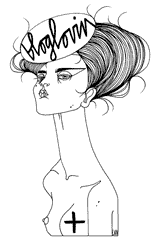
|
Julie Taymor’s 'A Midsummer Night’s Dream' @ Friday, August 19, 2016 27th July  This week's performance was a play, Julie Taymor’s 'A Midsummer Night’s Dream', a play on film. But unlike National Theatre screenings this one was from NYC, and showed the audience, and the last act was a play within a play, performed by a theatre troup, 'The Mechanicals' who are all labourers. Set upon a stage that appeared to be tiled with well, rectangular black tiles with white outlines paired with huge white flowing sheets (fabric) and projects, along with simple props created an effective, efficient and dramatic set. A dollhouse played the part of the Duke's house, poles held by faeries in black/the chorus on the black stage created an ominous forest that moved with the characters, and lastly white flowing sheets set the ethereal scenes of the faerie queen's rooms.  The chorus played by children, ballerinas played the faeries, subjects of the faerie queen Titania, dressed as bark trees they gather to hear Punk as mischievous narrator. Later they're held up by stage hands dressed in black, and create movements as if they were flying or hovering through the air. Punk more impressively drops into the scene through aerial wires himself. The children created the moving forest and later at the Duke's house played guests. It was a very good play/play on screen which we enjoyed. Sometimes screen is better than live, as there's the camera which zooms in on faces, portraying more emotion that if you sat in the back row. Also everything appears to the closer. But this overall, the concept on stage on screen is only good when designed that way, to be viewed on screen. Hermia has a lisp. That was annoying! 
Fun Fact: Punk is portrayed by Kathryn Hunter, Mrs. Arabella Figg (Harry Potter!).
Midsummer's a classic and one of Shakespeare's most popular works, a must see, though if you haven't read at it may be a bit confusing, with a few too many characters the first time around. - There are three groups: The Athenians (the civilians who live in Athens), The Fairies (who live in the woods), and, The Mechanicals (labourers, an ameture theatre group). - Hence there are three intertwining plots 
Beautiful styling, the contrast between the king and queen.
 Oberon's voice was familiar so I looked up where I might have seen him before! The short lived series of 'Selfie' Modern day Eliza Dolittle in NYC. 2. The Athenians - Hermia loves Lysander, but is engaged to Demetrius. Her friend, Helena loves Demetrius, but D loves L. The faerie king Oberon tells Puck to put a spell on Demetrius to make him fall in love with Helena. But Punk accidentally puts it on Lysander! So now everyone loves Helena, and no one loves Hermia. A sexy pillow fight in 50s lingerie follows. It's also fan service, in this adaptation. No I couldn't find a picture of them fully clothed. 3. The Mechanicals - They decided to practice in the woods, so there'd be no competing theatre troupes sneaking around. Nick Bottom gets his head turned into a donkey head. He sings, awakening Titania who falls for him. All the characters really carried their own weight here with everyone having a unique role, no merges. We loved Snout, with his preacher like lines. Nick Bottom (Max) is a New Yawk working stiff who’s gotta be at least part Italian. Francisco Flute (Zachary Infante) is a young Latino whose heavily-accented English is played for charm, Snout (Jacob Ming-Trent) is a burly African-American who breaks into Baptist-preacher cadences in his big moment, and Peter Quince (Joe Grifasi) has kind of a Woody Allen vibe going for him. Snug (Brendan Averett) and Starveling (William Youmans) are distinguished by other traits (which I guess tells you they’re white): the former is a gentle giant, as simple as he is huge, while the latter is played as sitcom-style gay. [Is it still okay to laugh at that? He’s very funny.] - Max
Have you seen or read 'A Midsummer's Night Dream'?
What is your favourite work from The Bard?
|

Hi. I'm Charlie. Capricorn. ISFJ. An Events Planner. An American, San Franciscan in Melbourne. This is a blog about food, events, desserts, hot chocolate & cupcakes, shopping, and the occasional beauty product review in between. A lifestyle blog by an American in Melbourne. Want to contact me? For invites, restaurant reviews and product reviews contact us at the address below. Click here to email me. I'm always after new places to try!  Follow Me? 

  Sticky Posts  The Cast The Cast My Wishlist My Wishlist All About Eggs All About Eggs Bursaria's Lemonade Bursaria's Lemonade Projects Half Done
Projects Half Done Adventures of Spending while Saving Adventures of Spending while SavingPublic Relations Archives July 2014 August 2014 September 2014 October 2014 November 2014 December 2014 January 2015 February 2015 March 2015 April 2015 May 2015 June 2015 July 2015 August 2015 September 2015 October 2015 November 2015 December 2015 January 2016 February 2016 March 2016 April 2016 May 2016 June 2016 July 2016 August 2016 September 2016 October 2016 November 2016 December 2016 January 2017 February 2017 March 2017 April 2017 May 2017 June 2017 July 2017 August 2017 September 2017 October 2017 November 2017 December 2017 January 2018 February 2018 April 2018 May 2018 June 2018 July 2018 August 2018 September 2018 November 2018 December 2018 January 2019 February 2019 March 2019 April 2019 May 2019 June 2019 July 2019 August 2019 September 2019 November 2019 December 2019 January 2020 February 2020 March 2020 April 2020 November 2020 December 2020 January 2021 May 2021 Thanks to... Original Base Design
Base Editor - Erma97 Basecoder - detonatedlove Original Header Design teacakehouse Coding Assistance (IT) Kitty_meow & Bala Kumaran Disclaimer Any resemblance to real or fictitious names, identities, characters, persons, whether living or dead, settings, situations, or other information, is purely coincidental and unintentional. Bloglovin' |








